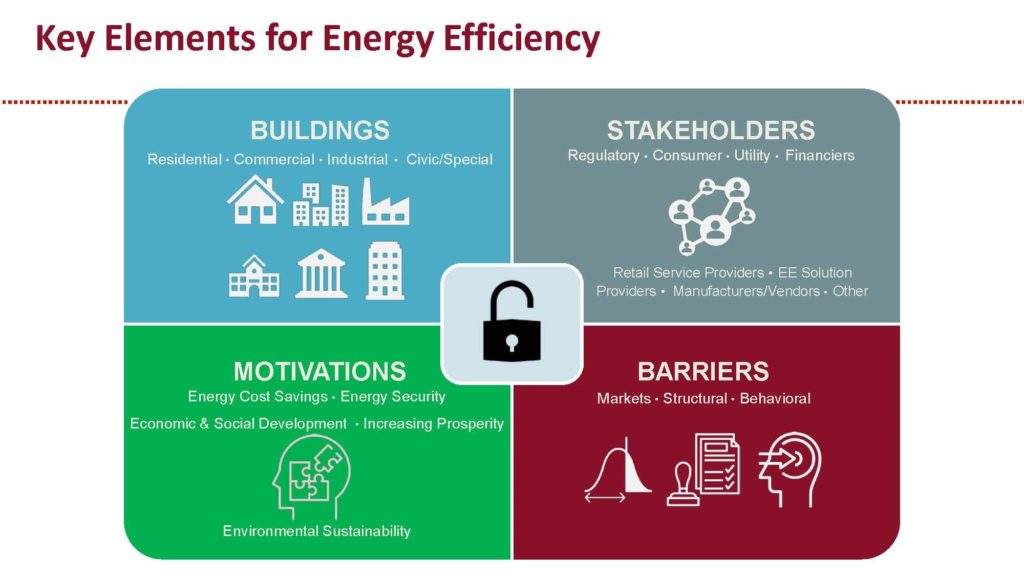Written by Dian Grueneich, Precourt Energy Scholar, Precourt Institute for Energy, Stanford University, with assistance from Steve Comello, Lead, Energy Business Innovations Focus Area, Stanford Graduate School of Business, and a co-instructor of the new Building Energy Efficiency course.
Building energy efficiency (BEE) has been a key element in efforts to provide an affordable, reliable, and sustainable energy system for decades. But currently the structure of the world energy market and its relationship to the built environment is going through a disruptive and transformational change due to the alarming impacts of climate change. A new-online course from Stanford University’s Center for Professional Development is now available to give students, professionals, and the public a good basis to understand the economics, energy systems and climate mitigation opportunities offered by BEE. The course, Building Energy Efficiency: Technology, Policy, and Finance is an integrated, comprehensive review of BEE, looking at its historical accomplishments, current efforts, and opportunities ahead.
WHY FOCUS ON BUILDINGS?
Buildings are critical not only for how we live our lives but because their energy use is a major component of energy systems and increasingly, a focus of carbon reduction and climate efforts. Here are some statistics from the International Energy Agency, for the U.S. for the year 2017:
- Buildings accounted for 20% of all energy consumed in the U.S. (including petroleum for transportation);
- Buildings accounted for 30% of all emissions, both from direct use of energy and indirect combustion to supply electricity from fossil fuel power plants; and,
- Building occupants spent $322 billion on electricity and $74 billion on natural gas.
Despite growth in energy demand, energy efficiency has helped curb the need for adding new power plants across the United States and saving consumers money on energy expenses. For example in 2014, the average per capita savings in the U.S. due to energy efficiency measures was about $2500, according to the American Council for an Energy Efficient Environment (ACEEE). So, the overarching questions are “What are the levers that enable BEE?” and “How can we maximize their effectiveness?” BEE is often siloed in the development and design process. This course works to break down those silos and offer ways to understand BEE from a systems, holistic approach.

WHAT ARE THE THREE KEY LEVERS OF BUILDING ENERGY EFFICIENCY AND HOW DO THEY INTERACT?
There are three key levers to BEE: Technology, Policy and Finance. Rather than focusing on just one, this course spends time on all three levers examining how they can work in integration. For example, technology expands what is possible, thereby being a key enabler for energy efficiency policies – such as energy efficiency resource standards, building codes, and appliance standards. There are three key policy tools – carrots (incentives), sticks (mandates), and sermons (information). The best policies use all three of these tools, in a coordinated fashion. These policy tools have been very successful in supporting the development of new BEE technologies, such as Zero Energy Buildings (ZEBs).
Likewise, technology and finance each enable the other. Advanced technology increases the probability that savings will occur from more efficient components and systems, particularly when there is widespread adoption and market experience. This is what we mean by being “bankable” – that a financier has high confidence in technology performance, and thus lowers the financing cost of the EE intervention. The benefits from new EE technologies go beyond saving energy and lowering energy bill costs. Quantification of non-energy benefits, such as improved comfort and lower O&M costs, are critical in supporting development of technology since much of the EE policy and market framework relies on cost-effectiveness.
The third intersection is that between policy and finance. Just as it does for technology, policy tools – the carrots, sticks, and sermons – support and enable BEE financing mechanisms and market investment. And, in turn, finance provides funding to implement policies, as well as transform entire markets.
WHAT ARE THE FOUR CRITICAL DIMENSIONS OF BUILDING ENERGY EFFICIENCY TO UNDERSTAND?
Our second approach, woven throughout the course, is discussion of four dimensions of BEE that must also be understood:
- Building Types. The four broad categories of buildings – residential, commercial, industrial and civic/special – are each amenable to different kinds of technological, behavioral, and programmatic EE interventions. And, within buildings, one must think about both components and systems.
- Stakeholders. Key are building owners, operators, landlords, and tenants. But architects, policymakers, utilities, and solutions providers have the ability to enable or hinder meaningful EE interventions so are also critical. And, there are a host of other active stakeholders in this space, such as trade associations, climate scientists, data analysts, banks, and environmental advocates.
- Motivations for BEE. Direct energy and cost savings are the traditional and primary motivators. However, non-energy benefits (NEBs) are important dimensions to consider when assessing projects holistically. NEBs are becoming increasingly more important as environmental sustainability and social and economic development benefits begin to be quantified with credible and more reliable techniques.
- Barriers can prevent or inhibit solution adoption. There are three main categories: market/availability; structural institutional; and behavioral/saliency.
WHAT’S NEXT?
BEE is a rapidly expanding, multi-billion-dollar global industry with many opportunities and challenges that will emerge over the next decade. Students in Building Energy Efficiency: Technology, Policy & Finance will gain a firm understanding of the four dimensions of BEE and the levers of technology, policy and finance that will need to be deployed to enable critical market transformation and meet the demands of global climate action. Learn more at: bee.stanford.edu.

